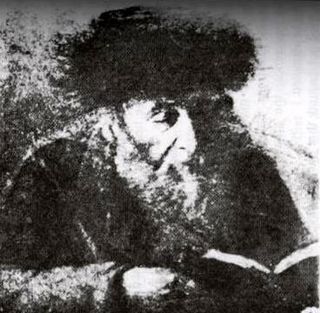
A Rebbe or Admor is the spiritual leader in the Hasidic movement, and the personalities of its dynasties. The titles of Rebbe and Admor, which used to be a general honor title even before the beginning of the movement, became, over time, almost exclusively identified with its Tzadikim.

Vizhnitz is the name of a Hasidic dynasty founded by Rabbi Menachem Mendel Hager. Vizhnitz is the Yiddish name of Vyzhnytsia, a town in present-day Ukraine.

Nadvorna is a Hasidic rabbinical dynasty deriving its name from the town of Nadvorna, (Nadvirna), today in Ukraine.

Rachmastrivka is a Hasidic dynasty named after the town of Rotmistrivka, Ukraine. It is an offshoot of the Chernobyl dynasty dating back to the 19th century.
Shotz is a Hasidic dynasty originating in the city of Suceava, Romania.

Skver is a Chasidic dynasty founded by Rebbe Yitzchok Twersky in the city of Skver, or Skvyra, in present-day Ukraine during the mid-19th century. Adherents of the rebbes of Skver are known as Skverer Hasidim.

Chernobyl is a Hasidic dynasty that was founded by Grand Rabbi Menachem Nachum Twersky, known by the name of his work as the Meor Einayim. The dynasty is named after the northern Ukrainian town of Chernobyl, where Rabbi Nachum served as the maggid. The lineage has continued to exist to this day, although not always with the name Chernobyl. Today there are several rebbes named Chernobyl. The central court is in Bnei Brak, headed by Rabbi Menachem Nachum Twersky.

Sanz is a Hasidic dynasty originating in the city of Sanz in Galicia. The dynasty was founded by the rebbe Rabbi Chaim Halberstam (1793–1876) who was the rabbi of Nowy Sącz and the author of the work Divrei Chaim by which name he is known as well.
Zvhil is the name of a Hasidic dynasty, with adherents today in Jerusalem, Boston, and New York.

There are two Hasidic Jewish dynasties known as Cleveland and both are considered to be a part of the Nadvorna dynasty.

Yitzhak Aharon Korff is the present Rebbe of Zvhil – Mezhbizh. Since 1975 he has been the Chaplain of the City of Boston and spiritual leader of Congregation Bnai Jacob, Zvhil–Mezhbizh Beit Medrash of Boston, Miami, and Jerusalem, serving also with the Chief Rabbis of Israel as Spiritual Leader of The Jerusalem Great Synagogue. He is a dayan of the BaDaTz Boston Beth din and Vaad HaRabbonim. He is also principal of Korff Associates, consultants in business, diplomacy and international law and relations, Consul to the government of Austria and publisher of the Boston-based Jewish newspaper The Jewish Advocate.

Avraham Yehoshua Heshel of Apt, popularly known as the Apter Rebbe or Apter Rov, was born in Żmigród, Poland in 1748 and died in Mezhbizh, Russian Empire in 1825.
Rabbi Boruch of Medzhybizh (1753–1811), was a grandson of the Baal Shem Tov. Reb Boruch was the first major "rebbe" of the Hasidic movement to hold court in Mezhbizh in his grandfather's hometown and Beis Medrash, which he inherited.
Zlotshov is the name of a Hasidic dynasty founded by Rebbe Yechiel Michel; Zlotshov or Zlotshev is the Yiddish name of Zolochiv, a town in present-day Ukraine. Known as the "Maggid of Zlotchev", Yechiel Michel was a disciple of the Baal Shem Tov, the founder of Hasidism, and of the Maggid of Mezritch.
Kozhnitz is the name of a Hasidic dynasty founded by the Kozhnitzer Maggid, Rebbe Yisroel Hopsztajn. Kozhnitz is the Yiddish name of Kozienice, a town in Poland.
The following charts illustrate the family of Rabbi Yisrael Baal Shem Tov, the founder of Hasidic Judaism.
Hornosteipel is the name of a Hasidic dynasty founded by Rebbe Yaakov Yisroel Twerski. Hornosteipel is the Yiddish name of Hornostaypil, a town in present-day Ukraine.
Skolya is a Hasidic dynasty named after the town of Skole in Eastern Galicia, where the founder of this dynasty lived and led his court.
Premishlan is a Hasidic dynasty. It was founded by Grand Rabbi Meir Hagadol of Peremyshliany

Hasidic Judaism in Lithuania is the history of Hasidic Judaism and Hasidic philosophy in Lithuania and parts of modern-day Belarus. Hasidic Judaism in Lithuania began with R. Aaron Perlow of Karlin (Karalin) (1736–1772), R. Menachem Mendel of Vitebsk (1730?–1788) R. Shneur Zalman of Liadi (Lyady) (1745–1812) and to a lesser extent R. Hayim Haykl of Amdur (Indura), all of whom were disciples of R. Dov Ber of Mezeritch (Mezhirichi), who in part was the successor to the R. Israel Baal Shem Tov who founded Hasidic Judaism in Western Ukraine. In its earliest years, Lithuanian Hasidism suffered immense persecution by the Lithuanian Misnagdic rabbinate, who attempted to ban and excommunicate Hasidism on several occasions in Lithuania beginning with R. Elijah b. Solomon Zalman of Vilna (1720–1797), who was the earliest disseminator of anti-Hasidic thought which flourished in Lithuania.













